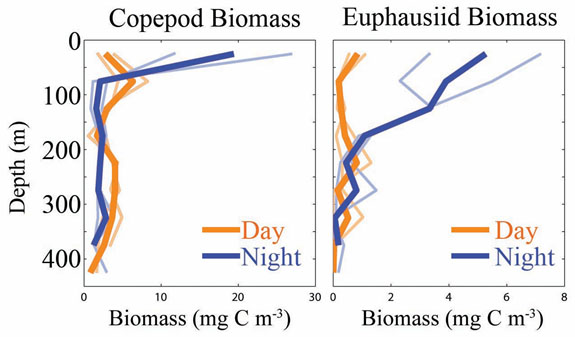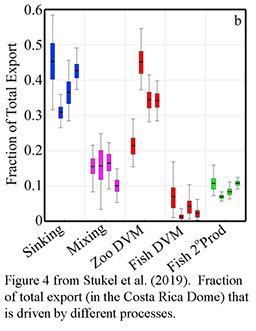Diel Vertical Migration and Active Transport
Many zooplankton, including some common groups like krill and copepods, migrate up and down in the ocean every day. This process is known as diel vertical migration. In most species, diel vertical migration involves the organisms swimming up to the surface at night and down to deeper depths during the day. Although many potential hypotheses exist for why organisms may undertake this behavior, the most likely reason is that they swim up to the surface at night to feed and descend to depth during the day to avoid visual predators (especially fish). Living in the surface during the day is quite dangerous for zooplankton, because they have nowhere to hide.
Regardless of the reason that the organisms undertake this behavior, diel vertical migration is the largest migration on our planet. Millions of tons of organisms swim up and down every single day. In the process of swimming up and down they take carbon (consumed when they feed on algae and other organisms in the surface) and respire it as carbon dioxide in the deep ocean. This leads to a net transport of carbon dioxide from the atmosphere to the surface ocean (where it is taken up by algae during photosynthesis) and into the deep ocean, where it can be sequestered from the atmosphere for a period of decades to centuries. This transport of carbon dioxide by diel vertical migrating zooplankton is something that we call active transport and is an important part of the biological pump and the global carbon cycle.

We have been studying active transport by vertically-migrating zooplankton in the California Current Ecosystem and other regions for many years. One of the tools that we use is a MOCNESS (Multiple Opening and Closing Nets and Environmental Sampling System). The MOCNESS is an instrument that has a series of nets that we can tell to open and close at different depths, thus allowing us to collect organisms from different depth ranges. Our collaborator, Mark Ohman, uses the MOCNESS routinely on CCE cruises to capture organisms from the sunlit surface ocean and the deeper twilight zone during the day and during the night. By looking at the differences between the abundance of organisms living in different depth layers at different times, we were able to identify which organisms (and how many of them) were vertically-migrating every day. Using estimates of the metabolism of these organisms, we could then calculate how much carbon dioxide they were transporting to depth every day (Stukel et al. 2013).
Such calculations are likely to generate an underestimate of the true amount of carbon transported by diel vertical migration for one simple reason: They assume that all migrating organisms go up and down exactly once per day with the same pattern (up at night and down during the day). While this may be true of most organisms, some have different patterns. Some organisms undertake reverse diel vertical migration and migrate to the surface during the day and to depth during the night. Other organisms undertake foraging sorties. They may feed in the surface at night, but if they catch enough prey they'll sink downwards while digesting then ascend to feed again - possibly multiple times in one night. Either of these patterns would lead to an underestimate of active transport using the approach described above. Furthermore, some organisms may die or be eaten while they are in the deep ocean, which would lead all of their carbon (not just the amount they would breathe out) to be lost to the deep ocean.

To quantify the potential true importance of active transport, we have been using linear inverse ecosystem modeling (LIEM) tools. LIEM is a powerful data assimilation tool that allows us to combine diverse oceanographic measurements with prior knowledge of the physiological capabilities of different groups of organisms into a coherent depiction of foodweb energy and matter flows. To understand the role of vertical migrants in the Costa Rica Dome, we incorporated rate measurements and isotopic information using LIEM. We found that diel vertical migration was responsible for approximately one third of the total carbon transport due to the biological pump and that it was roughly equal to the carbon flux due to sinking particles (Stukel et al. 2019). Graduate student Tom Kelly is currently working on a similar model to re-assess the importance of vertical migrants in the California Current Ecosystem.
This portion of our website is specifically designed as outreach to the general public. If you are a scientist look for details about our research, please click on the red 'For Scientists' link on the top right.
Contact: Mike Stukel (mstukel@fsu.edu)
Florida State University
Dept. of Earth, Ocean, and Atmospheric Science
Center for Ocean-Atmospheric Prediction Studies
